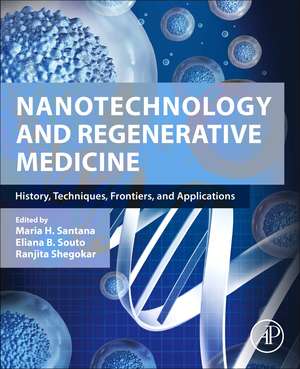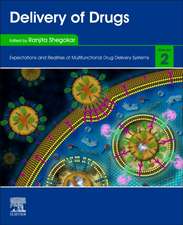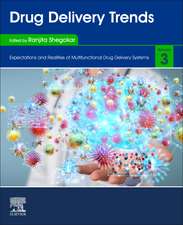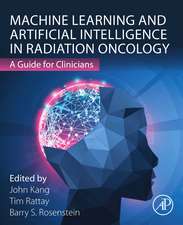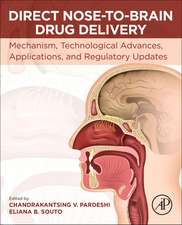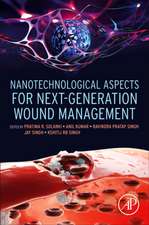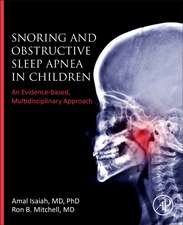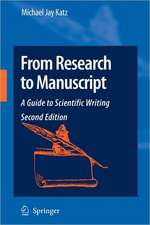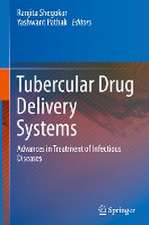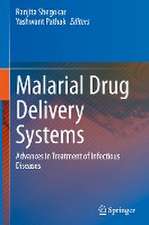Nanotechnology and Regenerative Medicine: History, Techniques, Frontiers, and Applications
Editat de Maria H. Santana, Eliana B. Souto, Ranjita Shegokaren Limba Engleză Paperback – 25 noi 2022
Over the last two decades, the integration of biomedicine with other engineering and biomaterial sciences promoted the development of nanotechnology and regenerative medicine toward mimicking the specialized stem cell niches to treat diseases with less invasive and efficient therapies. Innovative approaches in nanotechnology, such as targeting the immunological system, transporting drugs across blood–brain/BBB and blood–retinal barriers/BRB, directing active moiety to specific disease location/organs, encapsulation of multiple components, and promoting signalization and pathway-specific surfaces for cell interactions and growth, are indeed promising. On the other side, developments of biomaterial scaffolds to mimic the cell niches for interactions with stem cells in vitro or in vivo have tremendous potential.
The three-dimensional printing technology offers a base for a wide array of applications, for example, developing tissue constructs, mimetic organs, organoids, and organ-on-a-chip, thus avoiding the differences between animal model species and humans. Aiming closer to the natural environments, fresh autologous products from the blood, such as platelet-rich plasma (PRP), contain platelets and leukocytes, providing growth factors, cytokines, and proteins for the resident stem cells in the stages of regeneration. PRP also provides pain relief, reducing disabilities in elderly or diseased people. This book brings thought-provoking multidisciplinary topics on the diverse aspects of basic and applied sciences. The prime focus of the compilation is to understand the challenges researchers encounter in combining nanotechnology and regenerative medicine, ultimately integrating both disciplines for the benefit of the patient and offering them a ray of hope to be cured.
- Presents multi-disciplined knowledge on bench-to-bedside application of nanotechnology in regenerative medicines
- Highlights the fundamentals, frontiers, limitations, and challenges faced by regenerative medicines
- Exhibits synergy of biotechnology, nanomedicine, biomedicine, chemical-material engineering, pharmaceutical technology, and applied medical sciences in success of regenerative medicines
Preț: 909.50 lei
Preț vechi: 1185.88 lei
-23% Nou
Puncte Express: 1364
Preț estimativ în valută:
174.03€ • 181.70$ • 144.03£
174.03€ • 181.70$ • 144.03£
Carte tipărită la comandă
Livrare economică 28 martie-11 aprilie
Preluare comenzi: 021 569.72.76
Specificații
ISBN-13: 9780323904711
ISBN-10: 0323904718
Pagini: 614
Ilustrații: 100 illustrations (50 in full color)
Dimensiuni: 191 x 235 mm
Greutate: 1.04 kg
Editura: ELSEVIER SCIENCE
ISBN-10: 0323904718
Pagini: 614
Ilustrații: 100 illustrations (50 in full color)
Dimensiuni: 191 x 235 mm
Greutate: 1.04 kg
Editura: ELSEVIER SCIENCE
Cuprins
1. Evolution of nanotechnology in medicines
2. History and evolution of regenerative medicine
3. Nanotechnologies to deliver drugs through the blood-brain and blood-retinal barriers
4. Thermodynamics of nanoparticle-cell interaction
5. Nanogels for drug delivery: Physicochemical properties, biological behavior and in vivo applications
6. The role of blood brain and blood retinal barriers in drug delivery
7. Nanotechnology and stem cell therapy for combating COVID-19
8. Lipid nanoparticles-based semi-solid formulations for cosmetic applications: focus on cellulite
9. 3D Bioprinting: An innovative technique for biofabrication applied to regenerative medicine and tissue engineering
10. Stem cells, organoids, and cellular therapy
11. Growth factors, cytokines, and platelet-rich plasma
12. The biomaterial niche of platelet-rich plasma and hyaluronic acid matrices for tissue regeneration
13. Biomaterials application in wound healing management - from fundamental physiology to advanced technology
14. Nanoscaffolds and role of 3D printed surgical dressings for wound healing application
15. Platelet-rich plasma in pain management
16. Tissue engineering in wound healing
17. Role of neurogenesis in regenerative medicine
18. Gut microbiome interventions in regenerative medicine
19. Applications of nanotechnology in chronic diseases and tissue regeneration
20. Electrically conductive nanomaterials for advanced cardiac tissue regeneration
21. Toxicological screening of nanoparticles for biological applications: Drosophila melanogaster a model of new era
2. History and evolution of regenerative medicine
3. Nanotechnologies to deliver drugs through the blood-brain and blood-retinal barriers
4. Thermodynamics of nanoparticle-cell interaction
5. Nanogels for drug delivery: Physicochemical properties, biological behavior and in vivo applications
6. The role of blood brain and blood retinal barriers in drug delivery
7. Nanotechnology and stem cell therapy for combating COVID-19
8. Lipid nanoparticles-based semi-solid formulations for cosmetic applications: focus on cellulite
9. 3D Bioprinting: An innovative technique for biofabrication applied to regenerative medicine and tissue engineering
10. Stem cells, organoids, and cellular therapy
11. Growth factors, cytokines, and platelet-rich plasma
12. The biomaterial niche of platelet-rich plasma and hyaluronic acid matrices for tissue regeneration
13. Biomaterials application in wound healing management - from fundamental physiology to advanced technology
14. Nanoscaffolds and role of 3D printed surgical dressings for wound healing application
15. Platelet-rich plasma in pain management
16. Tissue engineering in wound healing
17. Role of neurogenesis in regenerative medicine
18. Gut microbiome interventions in regenerative medicine
19. Applications of nanotechnology in chronic diseases and tissue regeneration
20. Electrically conductive nanomaterials for advanced cardiac tissue regeneration
21. Toxicological screening of nanoparticles for biological applications: Drosophila melanogaster a model of new era
